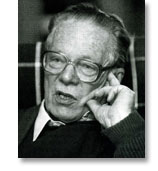|

Teivo Pentikäinen
(1917, Vyborg - 12 June 2006).
"...Teivo Pentikäinen was one of
the greatest contributors to the Theory
of Solvency in the second half of the 20th century. He did
pioneering work with
respect to the scientific foundations for the establishment of
the solvency
needed, and the optimal size and form of reinsurance already in
the 1950'ies".
Pentikäinen,
T. (1975) A model of stochastic-dynamic prognosis. An
application of risk theory to business planning,
Scandinavian Actuarial Journal, 29-53.
p. 29: "Our purpose is to attack just this problem ("what is
an insurance control system?" - V.M.) and to endeavor to
build up a picture of the management process of the
insurance business in its entirety (as far as possible) and
to place the risk theoretical aspects in it as a part among
numerous other parts, most of which are not of an actuarial
character. In this way some of the classical applications of
risk theory are amalgamated with the ideas of modern
business planning, especially with the technics of
long-range prognoses on the basis of different, often
alternative preassumptions or, as it is often called,
different business strategies".
p. 29: - "Is the theory ever practicable?" - "Probably much
too often mere intuition has guided the behavior of
management. Often many "experienced" managers take a
suspicious and deprecatory stand on theoretical
considerations, which they easily pass over with short
comments on their lack of practical value. However,
neglecting to clearly formulate the problems and the
principles of policies does not mean that the manager in
question does not, in fact, follow some strategy. On the
contrary, every way of decision making, even neglecting to
make a decision, is some kind of strategy. The difference is
only that the strategy of "practical men" can be a random
product of old traditions, more or less reliable intuitions,
etc. without any clear formulation and analysis of the
various alternative policies. A discussion on theoretical
aspects and on the theoretical points of view, even if the
direct numerical results are of little value, may anyway
direct attention to the statement and restatement of the
problems and to a conscious analysis of the facts and
possibilities".
p. 44: "One problem, both practical and theoretical, is how
to arrange the results of simulation to serve the management
in the best possible way. The idea of the use of the model
is, of course, to try to find \it optimal strategy, that
means a set of decision parameters, which give "the best
possible result". A primitive way of procedure is to repeat
the simulation process for different strategies and more or
less intuitively try to find suitable values for strategy
parameters. For example, fixing all the parameters but one
and giving to it some different value, perhaps the reaction
of the business flow can be seen as a function of this
particular parameter. By changing the "free parameter" new
corresponding results can be obtained, and perhaps step by
step it may be possible to come at least near to an optimal
strategy".
p. 45: "One great advantage of the analytic method, even if
it is based on very special assumptions, is that the
interdependence of the variables involved can be illustrated.
Even if the values obtained are far from the values obtained
by the original assumptions, probably at least the shape of
the interdependence can be preliminary studied in this way
which makes it easier to understand the structure of the
complicated model".
p. 45: "As a compromise between simulation and analytical
methods it may be advisable to perform some simplified
calculations analytically first. By finding suitable special
assumptions the analytical treatment of the problem can
perhaps be carried out. How far these analytical results are
valid also as a solution of the original problem, which is
based on more general and more realistic assumptions,
probably cannot be estimated. However, the decision
variables obtained analytically can serve initial variables
for simulation and the problem of optimization by means of
simulation can, perhaps, be made easier".
p. 44-45: "Instead of the simulation technics also other
methods could perhaps be used. Probably by certain suitable
assumptions in the form of interdependence of the model
variables the distributions of the status variables could be
expressed analytically. If these were successful, then the
optimization of the strategies would probably be solved also
analytically and the difficulties mentioned above overcome.
On the other hand, the model is so complicated and so many
variables are involved that the analytical treatment of the
whole problem would seem to be possible only by making very
restrictive assumptions. These must be made with regard to
the facility of the calculation operations, then it may be
necessary to sacrifice the model's ability to fit the
demands of practical management in an adequate way. For this
reason we have, at least at this first stage, preferred the
simulation technics".

Pentikäinen, T. (1988) On the
solvency of insurers. In book: Classical Insurance Solvency
Theory, ed. by D. Cummins and R. Derring, Kluwer, Boston
etc.
p. 30: "...the merit of the simulation approach is its great
flexibility to allow for quite general conditions and
assumptions ... Its drawback is that the results are subject
to sample inaccuracy, which may require large and time
consuming sample sizes".

"...He was the initiator and coauthor of the book Risk Theory, (London
1969 with R.E. Beard and E. Pesonen) and its renewed version,
Practical Risk Theory for Actuaries, (London 1994, with C.
Daykin and M. Pesonen)".
From the
Obituary of Teivo Pentikäinen in
ASTIN
Bulletin (2006), Volume 36, Number 2.



Beard, R.E., Pentikäinen, T.,
Pesonen, E. (1984) Risk Theory. The Stochastic Basis of
Insurance, 3-rd ed., Chapman and Hall, London etc.
Title page with a handwritten note by T. Pentikäinen.


Daykin, C.D., Pentikäinen, T.,
Pesonen, M. (1996) Practical Risk Theory for Actuaries.
Chapman and Hall, London, etc.

"...Furthermore, he significantly contributed to
the research on Risk Theory. With his many publications in
international journals over 45 years he had a great
influence on the work of many actuaries".
From the Obituary of Teivo Pentikäinen
in ASTIN
Bulletin (2006), Volume 36, Number 2.



Pentikäinen, T., Bonsdorff, H.,
Pesonen, M., Rantala, J., Ruohonen, M. (1989) Insurance
Solvency and Financial Strength. Finnish Insurance Training
and Publishing Co., Helsinki.


Rantala, J. (1984) An application of stochastic control
theory to insurance business, Acta Universitatis Tamperensis,
ser. A, vol. 164.

"...Even while retired, Pentikäinen participated in
the public debate about the insurance sector through his
books, lectures, evaluations, and writings. He was an
unyielding, at times even brisk, defender of the insurance
ideology. Good readiness for this was provided by his broad
knowledge which extended also to the details, continuous
following of international developments, and top-notch
capability of expression".
From the
Obituary of Teivo Pentikäinen in ASTIN
Bulletin (2006), Volume 36, Number 2.



From the correspondence with Prof. Pentikäinen:
1) Letter of Teivo Pentikäinen to
V.K. Malinovskii dated 29.10.1997
"...But notwithstanding the poor applicability to
practical considerations the ruin theory has a value in its
own right as a beautiful theoretical construction and has
had and still has great interest in the proceedings of the
risk theory's academic school. So far I know just that kind
of problem setting as your apply is not considered earlier
and might well be worth publishing in some professional
journal, the more because your technique may be applicable
also for other problems".
"...It is very delightful that you and other Russian
mathematicians are now joining the international actuarial
activities". 
2) Letter of Teivo Pentikäinen to
V.K. Malinovskii dated 20.12.1997
"...There may, however, be some parts in BPP-book which
where not taken into DPP-book but may still be of interest
and worthwhile to be kept in mind. They concern some
theoretical aspects that are not needed for our practical
presentation. The infinite-time ruin probability is one of
them as I referred to in my earlier letter. Furthermore, the
proposals for methods to evaluate finite-time ruin
probabilities (Section 6.9 of BPP) might be useful at some
applications, at least their further elaboration might be
worth attempting. Personally, I have never had time to
investigate them in any details. The numerical examples
which we had in the BPP (page 254) looked somewhat
promising. The methods can clearly be extended to models
which assume stochastic inflation, cycles, asset risks etc.
I am glad that our contact is continuing and wish you a
successful new year!"

"...Pentikäinen's sharp-witted humour and quick
intellect may have scared the unaccustomed other party to
the discussion, but maybe precisely because of these
characteristics he had a broad and faithful group of
friends".
From the Obituary of Teivo Pentikäinen in ASTIN
Bulletin (2006), Volume 36, Number 2.

|


